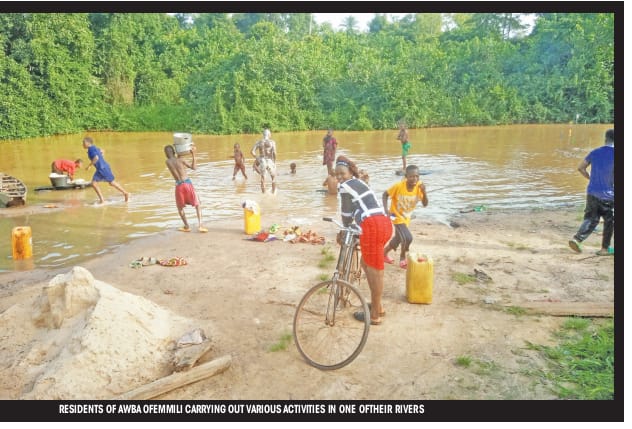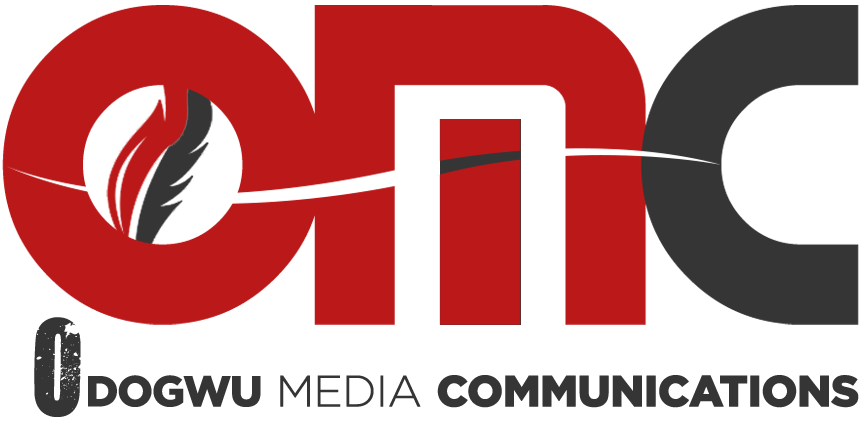Anambra’s rivers of succour and sorrow

Obinna Odogwu, Awka
They are rivers of succour. In the absence of boreholes and other sources of water, the rivers provide water for the daily use of the people. People fetch water to bathe, cook, drink and do other household chores.
But they are also rivers of sorrow. Since they are always polluted, indigenes frequently contract diseases from the rivers.
When Rev. Fr. Joseph Nwilo was posted to Awba Ofemmili community in Awka North Local Government Area of Anambra State for his pastoral assignment at St. Paul’s Catholic Church in October 3, 2020, he thought that the town was a place covered by water.
Fr. Nwilo’s thoughts and imaginations were understandable. The name of the community suggests so. And, in fact, anybody who has not been there or seen pictures of the town before would also think so.
Ofemmili, loosely translated, means across or over the water. So, for Fr. Nwilo, a town with such a name must have something to do with so many natural water bodies that might even be very massive in appearance.
To a fair extent, Nwilo’s imaginations were right. The town has quite a number of natural water bodies, big and small, crisscrossing its nooks and crannies. And they all find their ways into the Omambala River in Ayamelum LGA before emptying into the River Niger in Onitsha.
A youth leader in the community, Chukwueloke Anyafulu, told Saturday Sun that the town has a dozen rivers and many streams, which serve them different purposes.
“We have 12 main rivers in Awba Ofemmili. They are Otu Ezinwana, Otu Enugwu Agu, Otu Nweke Aya, Otu Ochoka Okwu, Otu Otaa, Otu Umuokpe, Otu Akpana, Otu Nwokoye, Otu Agu, Ezu Anaocha, Otu Umushite and Otu Ege.
“We fish in these rivers. We also drink from them. We scoop sands from there for building purposes and ferment cassava there too. We fetch water from there for domestic use – we wash clothes, swim and take our bath in these rivers.
“We wash fermented breadfruits there and take out the seeds. We do so many things in these rivers. We also cook with the water from there. This is because water has no enemies,” Anyafulu said.
When the reporter visited some of the rivers, he witnessed some of the earlier mentioned activities going on. Children were swimming; some elders were seen taking their bath, while some young women were sieving bags of cassava they dipped in the water four days earlier for fermentation.
Some of them came along with cans, buckets and other containers with which they would take the same water home for drinking, cooking and other domestic use. They had their bicycles there too.
Other residents of the community who spoke with the reporter corroborated Anyafulu’s explanation. Some of them were, however, quick to point out that they fetch the polluted rivers and streams for drinking because they had no better alternatives.
They said that they were aware that some diseases could be contracted from the contaminated waters, given the nature of activities that go on in them every day.
Indeed, there are a few waterborne diseases tormenting those who use water from such sources. Some of them, according to the World Health Organisation (WHO) are diarrhoea, cholera, dysentery, typhoid and polio.
It says that these diseases can be transmitted by microbiologically contaminated drinking water, and that it is estimated to cause 485,000 diarrhoeal deaths each year.
WHO, according to the information on its website, says that over two billion people live in water-stressed countries. It says that the situation is expected to exacerbate in some regions as a result of climate change and population growth.
“Globally, at least two billion people use a drinking water source contaminated with faeces. Microbial contamination of drinking water as a result of contamination with faeces poses the greatest risk to drinking water safety.
“While the most important chemical risks in drinking water arise from arsenic, fluoride or nitrate, emerging contaminants such as pharmaceuticals, pesticides, per- and polyfluoroalkyl substances (PFASs) and microplastics generate public concern.
“Safe and sufficient water facilitates the practice of hygiene, which is a key measure to prevent not only diarrhoeal diseases, but acute respiratory infections and numerous neglected tropical diseases,” it says.
WHO says that given the importance attached to safe drinking water, the Sustainable Development Goal (SDG) target 6.1 calls for universal and equitable access to safe and affordable drinking water for all.
The target, according to it, is tracked with the indicator of “safely managed drinking water services”; which is drinking water from an improved water source that is located on premises, available when needed, and free from faecal and priority chemical contamination.
The world health body said that in 2020, about 74 per cent of the global population amounting to 5.8 billion people used a safely managed drinking-water service.
“The remaining two billion people without safely managed services in 2020 included 1.2 billion people with basic services, meaning an improved water source located within a round trip of 30 minutes;
“Two hundred and eighty-two million people with limited services, or an improved water source requiring more than 30 minutes to collect water; 368 million people taking water from unprotected wells and springs; and 122 million people collecting untreated surface water from lakes, ponds, rivers and streams.
“Sharp geographic, sociocultural and economic inequalities persist, not only between rural and urban areas but also in towns and cities where people living in low-income, informal or illegal settlements usually have less access to improved sources of drinking water than other residents,” WHO posits.
The world health managers said that absent, inadequate or inappropriately managed water and sanitation services expose individuals to preventable health risks.
“This is particularly the case in healthcare facilities where both patients and staff are placed at additional risk of infection and disease when water, sanitation and hygiene services are lacking.
“Globally, 15 per cent of patients develop an infection during a hospital stay, with the proportion much greater in low-income countries.
“Inadequate management of urban, industrial and agricultural wastewater means the drinking water of hundreds of millions of people is dangerously contaminated or chemically polluted.
“Natural presence of chemicals, particularly in groundwater, can also be of health significance, including arsenic and fluoride, while other chemicals, such as lead, may be elevated in drinking water as a result of leaching from water supply components in contact with drinking water,” it says.
Going further, WHO says that some 829,000 people are estimated to die each year from diarrhoea as a result of unsafe drinking water, sanitation and hand hygiene.
“Yet diarrhoea is largely preventable, and the deaths of 297,000 children aged less than five years could be avoided each year if these risk factors were addressed.
“Where water is not readily available, people may decide hand washing is not a priority, thereby adding to the likelihood of diarrhoea and other diseases. Diarrhoea is the most widely known disease linked to contaminated food and water but there are other hazards,” it says.
The health organisation said that in 2017, over 220 million people required preventative treatment for schistosomiasis, which is an acute and chronic disease caused by parasitic worms contracted through exposure to infested water.
It said that in many parts of the world, insects that live or breed in water carry and transmit diseases such as dengue fever.
“Some of these insects, known as vectors, breed in clean, rather than dirty water, and household drinking water containers can serve as breeding grounds.
“The simple intervention of covering water storage containers can reduce vector breeding and may also reduce faecal contamination of water at the household level”, WHO adds.
Back home, the Nigeria Centre for Disease Control (NCDC) says that waterborne diseases are dealing badly with many Nigerians. It says that the ugly situation is worse in areas with inadequate access to clean water and sanitation facilities.
Using cholera as an example, NCDC says that the acute diarrhoeal disease caused by vibrio cholera, a gram negative rod-shaped bacterium, is endemic and seasonal in Nigeria. It describes it as a potentially life-threatening disease.
In a report published in April 2019, NCDC says that the country records annual outbreak of the disease which it says mostly occurs during the rainy season, revealing, however, that only two (O1 and O139) of the many serogroups of V. cholerae cause outbreaks.
“There have been seven pandemics of cholera worldwide, the last of which began in Indonesia in 1961, with an estimate of between 1.3 to 4.0 million cases and 21,000 to 143,000 deaths globally due to cholera every year.
“Cholera can be both endemic and epidemic. A cholera-endemic area is an area where confirmed cholera cases were detected during three out of the last five years with evidence of local transmission.
“In Nigeria, cholera is an endemic and seasonal disease, occurring annually; mostly during the rainy season and more often in areas with poor sanitation, with the first series of cholera outbreaks reported between 1970 and 1990.
“Major epidemics also occurred in 1992, 1995-1996, and 1997. The Federal Ministry of Health reported 37,289 cases and 1,434 deaths between January and October 2010, while a total of 22,797 cases of cholera with 728 deaths and case-fatality rate of 3.2 percent were recorded in 2011.
“Outbreaks were also recorded in 2018 with the Nigeria Centre for Disease Control (NCDC) reporting 42,466 suspected cases including 830 deaths with a case fatality rate of 1.95 percent from 20 out of 36 states from the beginning of 2018 to October 2018”, NCDC says.
The national disease control body says that the bacteria are transmitted mainly through the faeco-oral route via ingestion of contaminated food or water; and that humans are the main reservoir of vibrio cholera. It adds that water, mollusc, fish and aquatic plants are potential reservoirs.
Given the importance of safe drinking water, the United Nations (UN) made it number six on its Social Development Goals (SDGs), explaining that clean water is a basic human need which should be easily accessible to all.
“There is sufficient freshwater on the planet to achieve this. However, due to poor infrastructure, investment and planning, every year millions of people — most of them children — die from diseases associated with inadequate water supply, sanitation and hygiene”, it says.
As it affects children, the United Nations Children’s Fund (UNICEF), in a recent report on its website, says that about 5.0 million children under the age of five died in 2021.
“Globally, infectious diseases, including pneumonia, diarrhoea and malaria, remain a leading cause of under-five deaths, along with preterm birth and intrapartum-related complications”, it says.
UNICEF, originally called the United Nations International Children’s Emergency Fund in full, however, said that the global under-five mortality rate declined by 59 per cent from 93 deaths per 1,000 live births in 1990 to 38 in 2021.
“Despite this considerable progress, improving child survival remains a matter of urgent concern. In 2021 alone, roughly 13,800 under-five deaths occurred every day, an intolerably high number of largely preventable child deaths”, it stated.
Going further, UNICEF says that infant mortality is higher in the sub-Saharan Africa as children continue to face widespread regional and income disparities in their chances of survival.
“Sub-Saharan Africa continues to be the region with the highest under-five mortality rate in the world—73 deaths per 1,000 live births.
“In 2021, 1 in 14 children in sub-Saharan Africa died before reaching their fifth birthday—15 times higher than the risk for children born in high-income countries and 20 years behind the world average, which achieved a 1 in 14 rate by 2001.
“Disparities in child survival abound at the country level as well, where the risk of dying before age five for a child born in the highest mortality country is about 67 times higher than in the lowest mortality country, and all five countries with mortality rates above 100 deaths per 1,000 live births are in sub-Saharan Africa.
“With shifting demographics, the burden of child deaths is heaviest in sub-Saharan Africa. Approximately 83 per cent of all under-five deaths in the world in 2021 occurred in just two regions: sub-Saharan Africa (58 per cent) and South Asia (26 per cent).
“Due to growing child populations and a shift of the population distribution towards high-mortality regions, the share of global under-five deaths that occurred in sub-Saharan Africa increased from 31 per cent in 1990 to 58 per cent in 2021 and is expected to increase even further in the next few decades”, it says.
Beyond the waterborne diseases, there are other infectious diseases and conditions responsible for infant mortality worldwide, according to UNICEF.
“Globally, infectious diseases, including pneumonia, diarrhoea and malaria, remain a leading cause of under-five deaths, along with preterm birth and intrapartum-related complications.
“Moreover, malnourished children, particularly those suffering from severe acute malnutrition, are at a higher risk of death from these common childhood illnesses.
“Access to life-saving interventions is critical to ensuring steady mortality declines in low and middle-income countries”, it says.
In spite of these risks pointed out by WHO and UNICEF, residents of the community continue to use water from the polluted rivers for their daily needs.
The residents told the reporter that they drink water fetched from the filthy rivers and streams because they had no source of safe drinking water.
They said that they had made efforts in the past to drill boreholes in the town but they failed. They said that the experts in that industry they contracted to execute the job told them that it would be extremely difficult to get clean underground water there.
With that bad situation, Rev. Fr. Nwilo told the reporter that he feared that there might be a disease outbreak in the community someday.
“An epidemic can break out in this place and claim the lives of everybody. They have no source of water,” he stated.
The Catholic priest said that the situation of things in the community, as it affects drinking water, ran just opposite of his expectations when he was posted to the town about three years ago.
“When I was coming here, hearing Awba Ofemmili, Awba Ofemmili, I thought that it was a place you come, water is everywhere including drinkable one. But there’s no drinking water here. The people here source their drinking water from the river.
“For me, I buy the water I use from those selling with tanker. I also buy bags of sachet water from the township, which I drink. I cannot drink that water. If not you’ll be running the risk of a very strong ill health that will claim your life.
“So, that has been the experience. And that is why for those producing and selling sachet water, this place is a good market for them. It is a terrible situation and I wish to beg the state and the Federal Government to come to their aid.
“I know that the Federal Government can sponsor a borehole, no matter the cost. Even if it’s two alone, it will help to remedy the situation,” Fr. Nwilo said.
President-General of Awba Ofemmili Development Union, Chief Emenike Nwakaeze, told the reporter that he had personally tried to drill water for his people but it failed.
“Water is far deep in the ground here. It is only the government that can drill it because it has the financial power to do it. I have personally tried to drill water here but couldn’t achieve that.
“Here requires industrial borehole and it is very expensive. An organisation had come here in the past to drill borehole for us but could not get water. They didn’t seem to have the capacity to execute it,” he said.
Nwakaeze said that he was even more worried about the health of his people because some residents of the community still practised open defecation. He said that the faeces would end up in the rivers and streams, which the people would eventually drink.
“It is true that open defecation is stilled practised here. This is because we are farmers. But we discussed it in our meeting today. We want to do something about it. It is not everything that you call the government to do.
“By the grace of God, some persons made donations to support the work we are doing in the community. So, we are looking at building toilets in the community, village by village.
“We fetch water from Ezu River and that’s the water we drink. But you know that in that Ezu, somebody can defecate inside the river and then people will still fetch it for drinking. That’s a source of disease. It is very dangerous.
“People wash their clothes in those rivers; they wash their palm fruits there. Many activities take place in those rivers in this community. But even at that, people still fetch and drink them.”
Nwakaeze, while appealing for the state and federal governments’ assistance, revealed that many of his people were down with various ailments picked from the contaminated water.
“We don’t have drinking water. In fact, many people are sick because they had contracted disease from those rivers. Somebody will be swimming and then defecate or urinate inside it and somebody will come and fetch it for drinking,” Nwakaeze lamented.
A community leader, Ambrose Nweke, called on the state government to come to the aid of the town, saying that his people have suffered too much.
“We have rivers here but they are not clean for drinking. But the problem we have here is that we don’t have boreholes here. We use well. Even water from the well is not even good for drinking. We are finding it quite challenging. Our people contract diseases from there.
“Some people have come here to drill boreholes for us but after examining the land, they said that they won’t be able to get underground water here. They gave us well but it often dries up. That’s one of our major problems here,” Nweke said.
A member of the community, Chinedu Umebee, lamented the situation of things in the community, saying that they were heart-breaking.
“We don’t have drinkable water in this community. The rivers we have here are contaminated. They are carriers of diseases. Mosquitoes also breed there too and when they bite you, the next thing is malaria,” Umebee lamented.
A female member of the community, Udenka Okafor, however, told Saturday Sun that regardless of the filthy state of their rivers, good things come forth from there too.
“These rivers give us children and wealth. There are some children and wealth that come from the waters. Forget that some people are misbehaving. But you see all these rivers; they supply children, wealth and life. But God is the ultimate. We perform sacrifices here too.
Asked if she knew that some diseases such as cholera and typhoid could be contracted from drinking unclean water, she said: “I don’t know. We came to this world here seeing these rivers and we have been drinking them.”
Efforts to speak with the state Commissioner for Power and Water Resources, Mr Julius Chukwuemeka, on these issues proved abortive as he did not pick calls to his phone. He did not also reply a text message sent to him.






